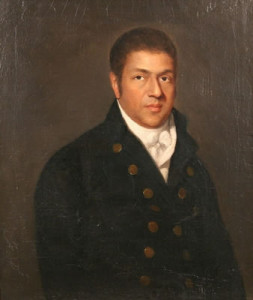A man of great energy and resolve, Paul Cuffee was born on the tiny island of Cuttyhunk, eleven miles offshore of New Bedford, MA. He was the seventh of ten children of Kofi Slocum, a freed African slave, and Ruth Moses, a Wampanoag Indian. His father took the name Slocum out of respect for the man who had freed him, John Slocum, a Quaker whose family owned Cuttyhunk.
His mother was descended from a long line of Wampanoags who had been friendly to the early white settlers. They were a hardworking, devout couple. Quakers themselves, they raised their children to be contributing citizens. They were free and ambitious, and they prospered.
When Paul Cuffee was eight, his parents bought a 116-acre farm in Westport, Massachusetts. This was an unusual move for a freed slave; it was 1766, still nearly a century before President Lincoln’s Emancipation Proclamation. All ten siblings grew to adulthood and lived successful lives, but Paul was the star of the family. He dropped Slocum as his last name and adapted his father’s first name instead, changing Kofi, an Ashanti word meaning “born on a Friday,� to Cuffee (though often spelled with just one “e�).
Cuffee showed an early affinity for boatbuilding, navigation, and trade. As a young teenager he built small boats and traded among the Massachusetts islands, as his father had done for many years. Later, he shipped aboard a whaler owned by the prominent Rotch family, Quaker merchants and whalers of New Bedford. During the Revolutionary War his ship was captured by the British and Cuffee was imprisoned in New York. Freed after three months, he made his way home, built his own vessel, and became a blockade runner, sailing on the darkest and stormiest nights to elude British patrols. He made a good living taking food and household supplies to Nantucket and Martha’s Vineyard. By the time he was in his early twenties, few people had greater knowledge of the currents, shoals, and weather variations of the Massachusetts islands.
In 1783, a few weeks before the end of the Revolution, Cuffee married a local Native American woman named Alice Pequit. They raised seven children. Encouraged by the Rotch family and other successful merchants, Cuffee set about building his own mercantile empire. Manned by African American and Native American crews, his ships could be found on both sides of the Atlantic. Eventually he opened a store in New Bedford to sell the goods he imported.
Paul Cuffee’s influence became steadily greater as he rose in the world. After a long struggle with politicians, he and his brother John won the right to vote in Massachusetts for landowning people of color. As a substantial landowner he had sharply questioned why he should be taxed without representation. Having had to teach himself to read and write, he was eager for his own children to learn these skills. He offered to help pay for the first public school in Westport, but some in the village did not want their children to sit next to Negroes. Cuffee’s generous reaction was to build a school and support a teacher on his own property, welcoming the children of his white neighbors as well as his own. Thus, what was possibly the first integrated school in America was opened by a man of color.
Of commanding presence and legendary integrity, Cuffee was admired by people of all colors. Upon his return in 1812 from a voyage to Sierra Leone, unaware that his country was at war with Great Britain, he found his ship impounded by the U.S. Revenue Service in Newport. Within six days, at record-breaking speed, Cuffee was in Washington knocking at the door of President Madison, who immediately arranged for the ship to be returned. Cuffee is said to have been the first person of color to enter the White House through the front door.
Paul Cuffee was one of the wealthiest men of color in the early 19th century America. He could have rocked on his porch in Westport watching his ships come home with precious cargoes, but as a devout Quaker he believed God would be better pleased if he kept working to help people who were less fortunate. He chose to devote his remaining energy to taking free Blacks to Africa, often at his own expense. Sierra Leone, an African colony supported by British Quakers, provided a fine opportunity for developing a farming economy. Unfortunately, Cuffee could not persuade the native chiefs that tilling the soil would lead to greater community prosperity than selling their captives as slaves.
In late 1816, tired by efforts at negotiation and by a very rough 66-day voyage home, Cuffee lost his health. On September 7, 1817, surrounded by family members, he said, “Let me pass quietly away.� So ended a life of extraordinary accomplishment. Today at PCS we tell our students that if Paul Cuffee could achieve all that he did in his day, surely they can overcome the obstacles they face today.
